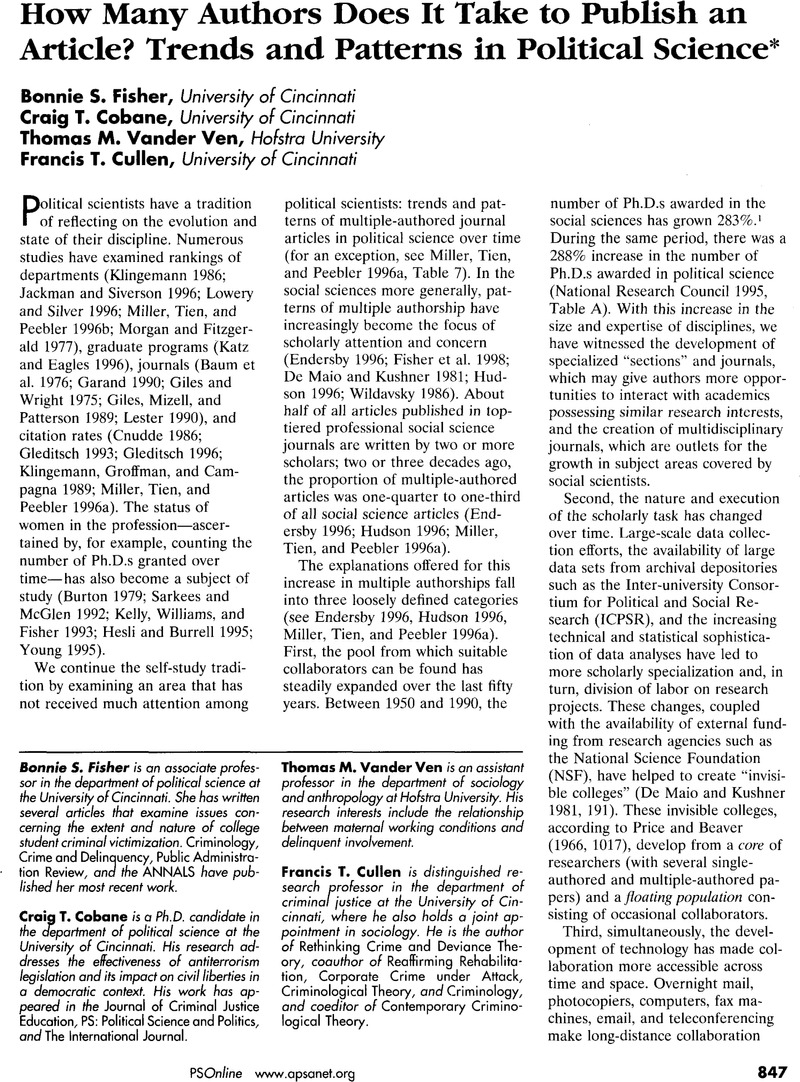Crossref Citations
This article has been cited by the following publications. This list is generated based on data provided by Crossref.
Anonymous
and
Anonymous
1999.
Tenure in a Chilly Climate.
PS: Political Science & Politics,
Vol. 32,
Issue. 1,
p.
91.
Finholt, Thomas A.
2002.
Collaboratories.
Annual Review of Information Science and Technology,
Vol. 36,
Issue. 1,
p.
73.
Moore, Michael T.
and
Griffin, Bryan W.
2006.
Identification of factors that influence authorship name placement and decisions to collaborate in peer-reviewed, education-related publications.
Studies in Educational Evaluation,
Vol. 32,
Issue. 2,
p.
125.
Sigelman, Lee
2006.
INTRODUCTION TO THE CENTENNIAL ISSUE.
American Political Science Review,
Vol. 100,
Issue. 04,
p.
v.
King, Gary
2006.
Publication, Publication.
PS: Political Science & Politics,
Vol. 39,
Issue. 1,
p.
119.
Maliniak, Daniel
Oakes, Amy
Peterson, Susan
and
Tierney, Michael J.
2008.
Women in International Relations.
Politics & Gender,
Vol. 4,
Issue. 01,
Chung, Kee H.
Cox, Raymond A.K.
and
Kim, Kenneth A.
2009.
On the relation between intellectual collaboration and intellectual output: Evidence from the finance academe.
The Quarterly Review of Economics and Finance,
Vol. 49,
Issue. 3,
p.
893.
Maier, Jürgen
2010.
Publizieren während der Promotion.
p.
125.
Resnik, David B.
and
Master, Zubin
2011.
Criteria for Authorship in Bioethics.
The American Journal of Bioethics,
Vol. 11,
Issue. 10,
p.
17.
Schucan Bird, Karen
2011.
Do women publish fewer journal articles than men? Sex differences in publication productivity in the social sciences.
British Journal of Sociology of Education,
Vol. 32,
Issue. 6,
p.
921.
Butler, Daniel M.
and
Butler, Richard J.
2011.
The Internet's effect on women's coauthoring rates and academic job market decisions: The case of political science.
Economics of Education Review,
Vol. 30,
Issue. 4,
p.
665.
Belgacem, Ines
and
Lamari, Moktar
2012.
Scientists' collaboration in the social sciences field: Investigating the determinants of scholarly collaboration in the Canadian context 2001–2008.
p.
1.
González-Alcaide, Gregorio
Melero-Fuentes, David
Aleixandre-Benavent, Rafael
and
Valderrama-Zurián, Juan-Carlos
2013.
Productivity and Collaboration in Scientific Publications on Criminology.
Journal of Criminal Justice Education,
Vol. 24,
Issue. 1,
p.
15.
Lemke, Richard
2013.
Perceptions on the Trend of Multi-Authored Collaboration: Results from a National Survey of Criminal Justice and Criminology Faculty.
Journal of Criminal Justice Education,
Vol. 24,
Issue. 3,
p.
316.
Su, Yu-Chang
Yu, Chilik
Lin, Min-Wei
and
Hung, Ling-Chun
2013.
An Assessment of Recent Authors and Authorship Patterns in Taiwan's Public Administration Research.
International Journal of Public Administration,
Vol. 36,
Issue. 2,
p.
84.
Fell, Clemens B.
and
König, Cornelius J.
2016.
Is there a gender difference in scientific collaboration? A scientometric examination of co-authorships among industrial–organizational psychologists.
Scientometrics,
Vol. 108,
Issue. 1,
p.
113.
Smith, Heather A.
and
Cornut, Jérémie
2016.
The Status of Women in Canadian Foreign Policy Analysis.
Journal of Women, Politics & Policy,
Vol. 37,
Issue. 2,
p.
217.
Mellon, Jonathan
Russon-Gilman, Hollie
Sjoberg, Fredrik
and
Peixoto, Tiago
2017.
Gender and Political Mobilization Online: Participation and Policy Success on a Global Petitioning Platform.
SSRN Electronic Journal,
Henriksen, Dorte
2018.
What factors are associated with increasing co-authorship in the social sciences? A case study of Danish Economics and Political Science.
Scientometrics,
Vol. 114,
Issue. 3,
p.
1395.
Onwuegbuzie, Anthony J.
Wilcox, Rachael
Gonzales, Vanessa
Hoisington, Susan
Lambert, Jarod
Jordan, John
Aleisa, Majed
Benge, Cindy L.
Wachsmann, Melanie S.
and
Valle, Rachel
2018.
Collaboration Patterns Among Mixed Researchers: A Multidisciplinary Examination.
INTERNATIONAL JOURNAL OF MULTIPLE RESEARCH APPROACHES,
Vol. 10,
Issue. 1,
p.
437.





